The MGA With An Attitude
Master Cylinder COVER LEAKS - Dual m/c - HT-111
At 08:05 PM 1/8/05 -0500, Chuck Jackson wrote:
"I used a Gunson Pressure Bleeder .... there was copious air leakage at the cork lid gasket. .... I couldn’t get the machine screws any tighter with a normal screwdriver, so I .... torqued a bit more using a ratchet. "
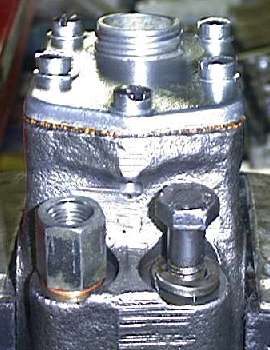
Yikes! Don't do that.
".... leakage has been seriously decreased, but there is still some leakage at the rearward corners."
Capturing a cork gasket between two machined surfaces should produce a pressure tight joint with only normal wrist torque on a plain screwdriver. I commonly apply 30 psi with my pressure bleeder with no leakage. The cork gasket is soft and fairly thick. The master cylinder lid is soft aluminum and not particularly stiff. Too much torque on the screws can smash the gasket in local areas around the screws and may deform the cover.
"Should I remove the lid and apply a gasket sealant? .... I was disinclined to use a sealant on a brake cylinder gasket."
Your intuition is correct. Do not use any sealant on the cover gasket. DOT 5 (silicone fluid) will not attack the sealant, but DOT 3 or DOT 4 fluid might. A worse problem is that some sealant might be squeezed from the gasket joint into the reservoir, which could then clog up the flow control check valve in the brake side of the master cylinder. Some errant sealant might also make its way down the lines to mess up operation of the slave cylinders, or possibly even clog bleeder valves.
"If I remove the lid can I reuse this gasket .... or is it forever useless (like a head gasket)?"
There is a fine line between frugal and foolish when it comes to BRAKES. A new cork gasket may be very forgiving. But if you have mashed it out of shape with a bent lid, then it may be destroyed. Frugality is one of my favorite subjects though, especially if it avoids a delay for another pars order. If you can get the cover flat, and it will then seal up properly with the (slightly) used cork gasket, then it would be okay.
"Should I just wrap a rag around the lid and merrily (and quickly) bleed away, knowing that during operation the lid is not under pressure, and I shouldn’t see any leakage after I remove the Bleeder."
Sorry, but no leakage is allowed, either for pressure bleeding or for normal use. Even a small amount of leakage can make a HUGE mess when using a pressure bleeder. In operation at road speed, sloshing of the fluid will also cause it to weep out through any small gasket leak. I know we have a 1500 model flat cover here. For the 1600 model with the raised cover the gasket is normally submerged in fluid.
Remove the cover and lay a straight edge across the seal surface. It must certainly be bent if it will not seal with a new cork gasket. (See pictures of inverted cover).
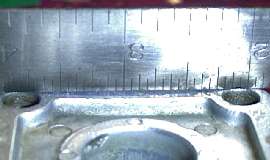 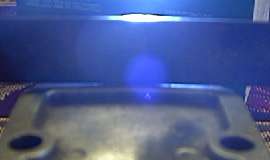
Font end pulled down at corner screws. - Back end pulled down at center screw.
Yup. that's definitely bent. Place a sheet of medium grit emery paper grit side up on a VERY flat work surface. A sheet of glass or a formica counter top works well. Oil the emery paper. Place bottom of lid on the paper and rub vigorously. Inspection of the underside of the lid will reveal buff marks on the high spots. (Photo below left).
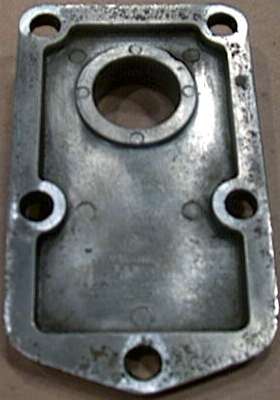 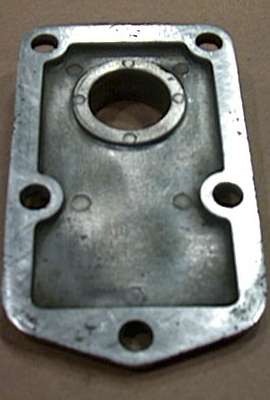
Sanding bent cover reveals high spots. - Sanding until flat shows even buff finish.
If the cover is severely bent, you might save some time by straightening it some before trying to sand it flat. Using the straight edge as a guide you might squeeze the edge of the cover in a vice (soft jaws please). You might otherwise hold one edge in a vice and bump the cover with the heal of your hand to bend it slightly more toward flat. Use finesse please, as the 1500 type flat cover my be easily bent. When you get within a thin fingernail thickness of the straight edge you can go back to sanding.
When the cover is sanded completely flat you should have even buff finish all over the whole contact surface. (Picture above right). Turn the MC upside down and do the same there. This should require only a little sanding to polish down any burrs around the screw threads. (Picture at right). With two flat surfaces the cork gasket should seal perfectly, even with high pressure.
Clean the parts well (no sanding grit allowed in the hydraulic system). Reassemble and pressure test again with an empty pressure bleeder. Be sure the gasket for the screw on cap seals as well before pressurizing with fluid. You only have to do this right just once. Then as long as you don't over tighten the screws it should be a permanent fix.
|
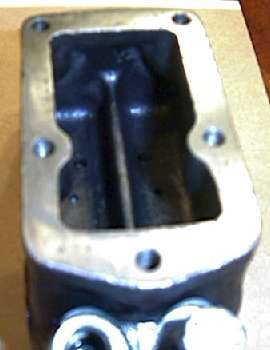
|
At 09:36 PM 1/9/05 -0500, Chuck Jackson wrote:
"Wow, after catching hell from my wife (but not desisting) for using our granite kitchen counter top as the flat surface, and after 30 minutes of polishing, both surfaces were almost right. See the horror story, bowed at one end, arched at the other end, first polishing showing the really high spots, and final results that I went with.
"I plugged the output ports and pressurized it, with no sign of leakage at all (no bubbles with light machine oil on the gasket). I reinstalled it and had my wife (who can hear like a hawk) check the installed MC for hissing sounds, and apparently I have a pressurized system."
Thanks to Chuck Jackson for sharing the pictures (and for the patience to do it right).
|





